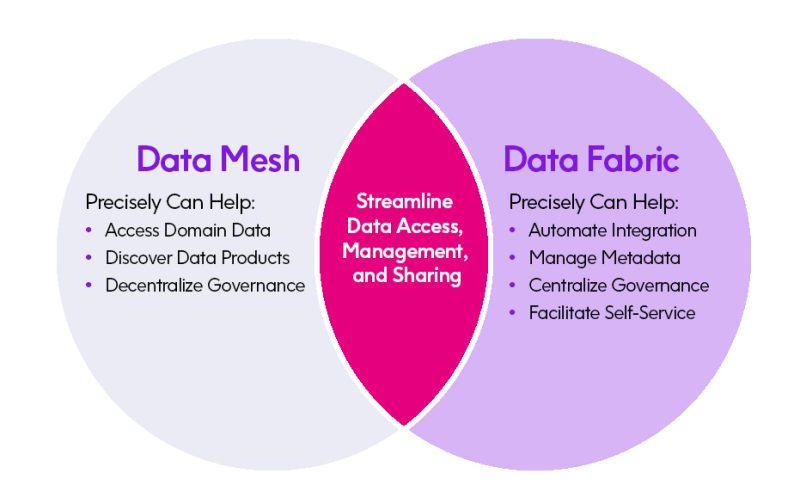
Unraveling the Threads: Data Fabric vs Data Mesh for Modern Enterprises

Key Takeaways
- Data fabric and data mesh are modern data management architectures that allow organizations to more easily understand, create, and manage data for more timely, accurate, consistent, and contextual data analytics and operations.
- Both architectures tackle significant data management challenges such as integrating disparate data sources, improving data accessibility, automating management processes, and ensuring data governance and security.
- While data fabric and data mesh can function independently, they are increasingly viewed as complementary strategies. Data fabric lays a cohesive technical foundation for data integration, while data mesh decentralizes data

Managing and leveraging vast amounts of data across diverse environments is one of the biggest organizational challenges in modern history. As data continues to grow in volume and complexity, a sustainable manual way to manage or make sense of it, much less leverage it for a competitive advantage is getting more difficult.
Two modern architectures are being mentioned that can revolutionize how large data volumes are used and managed – data fabric and data mesh. The choice between the two depends on your business needs. Let’s explore the similarities – and the differences in their approaches.
What is data fabric
Data fabric is a data management architecture that allows you to break down data silos, improve efficiencies, and accelerate access for users. It provides a unified and consistent data infrastructure across distributed environments, accelerating analytics and decision-making. By integrating data from multiple sources and abstracting complexity, data fabric allows users to interact with consistent, high-quality data as if it were centralized. This process relies heavily on metadata, which, to be optimally helpful, must be captured, catalogued, and activated to analyze relevant information about your data and its usage. Data fabric centralizes data governance and security to ensure privacy, secure access, and high-quality data.
Problems it solves
Data fabric addresses key data management and use challenges. Data fabric
- Addresses the challenges of integrating data from various sources across the landscape, creating a unified view.
- Automates data management next best actions or recommendations.
- Eliminates user uncertainty about the freshness of data they’re using and obstacles to collaboration.
- Improves data accessibility so the right people can self-serve the right data at the right time.
- Scales to manage increasing volumes of data
- Solves inadequate data governance, security, and compliance measures.
- Addresses inefficiencies in workflows and operational efficiencies to enhance productivity,
Challenges
As mentioned in Modern Data Management Essentials: Exploring Data Fabric, data fabric isn’t a solution you can buy off the shelf. It’s a combination of components that can be complex to implement. Like many fields, the technology field is experiencing a skill shortage, and many organizations struggle with a lack of resources. In support of a data fabric, you’ll need experts and support tools in several areas to make it work, including robust data integration and data governance capabilities. Though you don’t have to have a mature metadata management strategy to start working on a data fabric, it will contribute to a successful fabric. Finally, data fabric requires organizational changes such as new workflows and responsibilities; everyone must be on board with the new direction.
Who it’s for
Data fabric will benefit organizations with complex, decentralized data that need a unified approach to managing, accessing and using data across their environment. Large data- intensive organizations with multiple data sources, businesses that would benefit from near real-time analytics, industries with stringent compliance or security regulations, or those that can benefit from AI, machine learning, and advanced analytics will also see value.
Read the white paper
Data Fabric vs. Data Mesh: Centralized Control or Decentralized Democracy?
We’ve partnered with Sanjeev Mohan, former Gartner analyst and principal at SanjMo, to help you understand the essentials of data mesh, data fabric, and which might be right for you.
What is data mesh
Data mesh takes a decentralized approach to data management and data asset delivery. In this model, data ownership remains with the domain teams. Domain owners and subject matter experts are responsible for managing data quality, data governance, and producing data assets or products (if that’s a goal) that can be discovered and accessed on demand. By decentralizing ownership, teams may be more agile and innovative, data assets are consistent, approved, and accessible. You can learn more about data mesh in this blog post “Demystifying Data Mesh”.
Problems it solves
Data mesh addresses key data management and use challenges.
- Replaces on-demand bottlenecks with self-service access to approved data and data products.
- Eliminates time-to-market delays for services and products.
- Prevents inconsistent or duplicative data products from being created.
- Increases governance over data products for greater autonomy that still adheres to corporate policies.
Challenges
While data mesh solves some of the traditional challenges of centralized architecture, it has its own challenges. The architecture is complex, and there’s no established best practice. There’s also a lot of confusing guidance out there, compounded by a lack of skills in the industry. Decentralized data requires careful attention to data governance at the domain level; without centralized governance, data assets and products may be inconsistent across the organization. Finally, domain owners must be willing to accept responsibility and accountability for data product governance and sharing.
Who it’s for
Data mesh can benefit large organizations with complex environments where distributed teams are responsible for developing data products. Empowering domain teams to be more autonomous and efficient would benefit any organization that relies heavily on advanced analytics, including those that need to be exceptionally nimble. If an organization would benefit from more collaboration across teams, data mesh delivers a user-friendly self-service interface that catalogs data products encouraging siloes to work together.

Better together?
So, which architectural approach is better? Some reports indicate that the future may see them being complimentary – where data fabric is the technical foundation for data management, while data mesh serves as the operational model for delivering data assets or data products. Together, they’re the whole package. Bottom line, data management architectural strategies are evolving to accommodate more modern demands, and data fabric and data mesh will certainly be considerations for data-driven organizations.
We’ve partnered with Sanjeev Mohan, former Gartner analyst and principal at SanjMo, to help you understand the essentials of data mesh, data fabric, and which might be right for you. Read the white paper “Data Fabric vs. Data Mesh: Centralized Control or Decentralized Democracy?” today.


